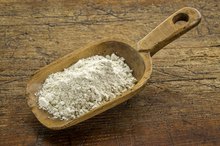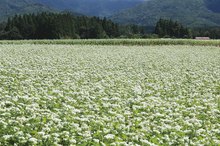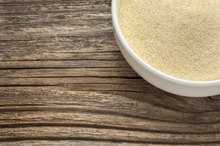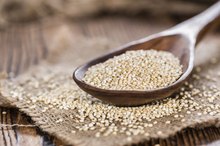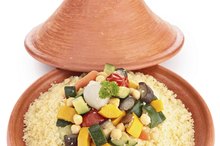What does fact checked mean?
At Healthfully, we strive to deliver objective content that is accurate and up-to-date. Our team periodically reviews articles in order to ensure content quality. The sources cited below consist of evidence from peer-reviewed journals, prominent medical organizations, academic associations, and government data.
The information contained on this site is for informational purposes only, and should not be used as a substitute for the advice of a professional health care provider. Please check with the appropriate physician regarding health questions and concerns. Although we strive to deliver accurate and up-to-date information, no guarantee to that effect is made.
What Is Sorghum Flour?
Grains that have been used for centuries around the world are becoming increasingly popular as food sources in the United States as well. Sorghum and the flour made from it is an example of one of these grains 1. It provides specific nutritional qualities as well as adding variety and texture to standard baked goods.
Background and History
A grain common in Africa and India throughout history, sorghum is also grown in the United States and is becoming more widely available for consumer purchase. According to the U.S. Grains Council, sorghum is the third most important cereal crop nationally and the fifth most important around the world 1. Sorghum has long been used in the United States as a grain feed for animals but is now viewed as an alternative grain for human consumption 2. The whole grain kernel is ground into a flour that can be used for cooking and baking. It is also known as milo flour.
- A grain common in Africa and India throughout history, sorghum is also grown in the United States and is becoming more widely available for consumer purchase.
Nutrition Content
Allergy to Sourdough Bread
Learn More
Sorghum flour is packed with vitamins, minerals, fiber and protein according to the USDA National Nutrient Database 4. Just 1 cup of sorghum flour delivers more than 15 percent of your recommended daily intake of riboflavin and potassium; more than 25 percent of the RDI of niacin and thiamin; more than 40 percent of the RDI of iron and protein and nearly 50 percent of your recommended intake of fiber and phosphorous.
Gluten-Free
A major reason why sorghum flour has entered the health food spotlight is because it is gluten-free. Gluten is a protein found in many grains such as wheat, barley, rye and oats. While some people choose to eat gluten-free foods because of mild intolerance, this type of diet is essential for those who have celiac disease. The disease is an autoimmune disorder caused by a reaction to gluten that can result in the malabsorption of nutrients as well as severe abdominal pain and related symptoms. People with celiac disease must eat a gluten-free diet, which makes sorghum flour ideal for cooking and baking.
- A major reason why sorghum flour has entered the health food spotlight is because it is gluten-free.
- While some people choose to eat gluten-free foods because of mild intolerance, this type of diet is essential for those who have celiac disease.
Cooking With Sorghum Flour
How to Replace Quinoa Flour for Protein Powder
Learn More
Traditionally this flour has been used as a cereal food to create pancakes and fermented and unfermented porridges and flatbreads -- such as the jowar roti in India -- throughout different cultures. In the United States, it is becoming more common to use sorghum flour in baked goods. It can be added or substituted in any recipe that calls for flour such as cakes, cookies, breads and muffins. Sorghum flour has a bland flavor that can be beneficial for baking because it won't add an unfamiliar or distinctive taste. However, because of its lack of gluten, it does have an influence on the texture of baked goods. Gluten acts as a binder in foods, so consider adding an alternative binder such as cornstarch to recipes when using sorghum flour. In addition, sorghum often produces a drier, crumbly final product. Adding extra oil or another fat source and eggs can improve the texture, and adding a leavening agent such as baking powder or baking soda will help the dough rise.
- Traditionally this flour has been used as a cereal food to create pancakes and fermented and unfermented porridges and flatbreads -- such as the jowar roti in India -- throughout different cultures.
- Gluten acts as a binder in foods, so consider adding an alternative binder such as cornstarch to recipes when using sorghum flour.
Where to Find It
Sorghum flour can be found in many specialty health food stores in the same section as other grains and flours 1. You might also find it in the gluten-free section if the store has one. It can also be found at ethnic food markets. It may be listed under another name. For example, in the Indian culture sorghum flour is referred to as jowar atta.
- Sorghum flour can be found in many specialty health food stores in the same section as other grains and flours 1.
Related Articles
References
- U.S. Grains Council: Sorghum
- Alternative Field Crops Manual: Sorghum Grain
- National Institutes of Health Celiac Disease Awareness Campaign: Celiac Disease
- USDA National Nutrient Database: Sorghum Flour
- Celiac Disease Foundation. Gluten-Free Foods.
- U.S. Food & Drug Administration. Gluten and Food Labeling. Updated July 16, 2018.
- Celiac Disease Foundation. Sources of Gluten.
Writer Bio
Lori Rice is a freelance health and travel writer. As an avid traveler and former expat, she enjoys sharing her experiences and tips with other enthusiastic explorers. Rice received a master's degree in nutritional sciences and a bachelor’s degree in nutrition, fitness and health.

